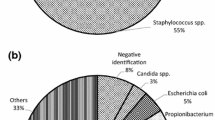Abstract
Heart valve allografts are typically processed at 4°C in North America, including the step of antibiotic decontamination. In our own experience with heart valve banking, we often observe persistent positive cultures following decontamination at wet ice temperature. We hypothesized that warmer temperatures of incubation might increase the efficacy of the decontamination procedure. In a first series of experiments, 12 different bacterial species were grown overnight, frozen in standardized aliquots and used directly to inoculate antibiotic cocktail aliquots at 105 colony-forming units (CFU)/ml. The antibiotic cocktail contains vancomycin (50 μg/ml), gentamicin (80 μg/ml) and cefoxitin (240 μg/ml) in Dulbecco’s Modified Eagle’s Medium. Inoculated aliquots were incubated at 4, 22 and 37°C and CFUs were determined at regular intervals up to 24 h post-inoculation. In a second set of experiments, 10 heart valves were spiked with 5000 CFU/ml and incubated with antibiotics at 4 and 37°C for 24 h. The final rinse solutions of these heart valves were filtered and tested for bacterial growth. After 24 h of incubation, CFUs of all 12 bacterial species were reduced by a factor of only one to two logs at 4°C whereas log reductions of 3.7 and 5.0 or higher were obtained at 22 and 37°C, respectively. Most microorganisms, including Staphylococcus epidermidis, Lactococcus lactis lactis and Propionibacterium acnes survived well the 24-h antibiotic treatment at 4°C (<1 Log reduction). All 10 heart valves that were spiked with microorganisms had positive final rinse solutions after antibiotic soaking at 4°C, whereas 8 out of 10 cultures were negative when antibiotic decontamination was done at 37°C. These experiments show that a wet ice temperature greatly reduces the efficacy of the allograft decontamination process as microorganisms survived well to a 24-h 4°C antibiotic treatment. This could explain the high rate of positive post-processing cultures obtained with our routine tissue decontamination procedure. Increasing the decontamination temperature from 4 to 37°C may significantly reduce the incidence of post-disinfection bacterial contamination of heart valves.

Similar content being viewed by others
References
Angell JD, Christopher BS, Hawtrey O, Angell WM (1976) A fresh, viable human heart valve bank: sterilization, sterility testing, and cryogenic preservation. Transplant Proc 8:139–147
Barratt-Boyes BG, Roche AH, Subramanyan R, Pemberton JR, Whitlock RM (1987) Long-term follow-up of patients with the antibiotic-sterilized aortic homograft valve inserted freehand in the aortic position. Circulation 75:768–777
Gall K, Smith S, Willmette C, Wong M, O’Brien M (1995) Allograft heart valve sterilization: a six-year in-depth analysis of a twenty-five-year experience with low-dose antibiotics. J Thorac Cardiovasc Surg 110:680–687
Ireland L, Spelman D (2005) Bacterial contamination of tissue allografts—experiences of the donor tissue bank of Victoria. Cell Tissue Bank 6:181–189
Jashari R, Tabaku M, Van Hoeck B, Cochez C, Callant M, Vanderkelen A (2007) Decontamination of heart valve and arterial allografts in the European Homograft Bank (EHB): comparison of two different antibiotic cocktails in low temperature conditions. Cell Tissue Bank 8:247–255
Kirklin JW, Blackstone EH, Maehara T, Pacifico AD, Kirklin JK, Pollock S, Stewart RW (1987) Intermediate-term fate of cryopreserved allograft and xenograft valved conduits. Ann Thorac Surg 44:598–606
Kuehnert MJ, Clark E, Lockart SR, Soll DR, Chia J, Jarvis WR (1998) Candida albicans endocarditis associated with a contaminated aortic valve allograft: implications for regulation of allograft processing. Clin Infect Dis 27:688–691
Meyer SR, Nagendran J, Desai LS, Rayat GR, Churchill TA, Anderson CC, Rajotte RV, Lakey JR, Ross DB (2005) Decellularization reduces the immune response to aortic valve allografts in the rat. J Thorac Cardiovasc Surg 130:469–476
Parker R (1997) An international survey of allograft banks. In: Yacoub MH (ed) Cardiac valve allograft. Science and practice. Springer, New York, pp 5–9
Stolinski J, Marek G, Marcinkowska Z, Jaskier M, Barecka D, Bartus K, Kapelak B, Sadowski J, Dziatkowiak A (2006) Allogenic heart valve bank in the Department of Cardiovascular Surgery and Transplantology of Jagiellonian University in Cracow—23 years experience in the treatment of aortic valve or aortic root diseases. Cell Tissue Bank 7:175–182
Strickett MG, Barratt-Boyes BG, MacCulloch D (1983) Disinfection of human heart valve allografts with antibiotics in low concentration. Pathology 15:457–462
Yacoub M, Kittle CF (1970) Sterilization of valve homografts by antibiotic solutions. Circulation 41:II29–II32
Acknowledgements
The authors thank Isabelle Paquet for the preparation of heart valves and Annie Beauséjour as well as Éric Ducas for the realization of spiking experiments. We also thank Jean-François Leblanc for his critical review of this manuscript.
Author information
Authors and Affiliations
Corresponding authors
Rights and permissions
About this article
Cite this article
Germain, M., Thibault, L., Jacques, A. et al. Heart valve allograft decontamination with antibiotics: impact of the temperature of incubation on efficacy. Cell Tissue Bank 11, 197–204 (2010). https://doi.org/10.1007/s10561-009-9155-y
Received:
Accepted:
Published:
Issue Date:
DOI: https://doi.org/10.1007/s10561-009-9155-y




